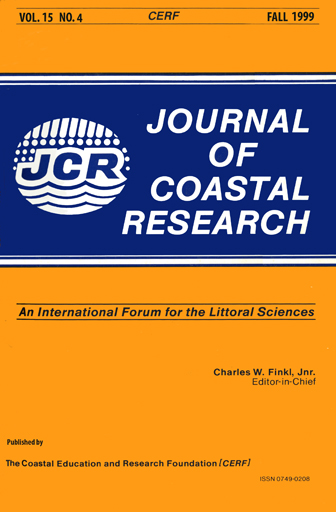The Influence of Seagrass on Shell Layers and Florida Bay Mudbanks
Keywords:
Sedimentation, mollusk, carbonate sediments, seagrass, coastal processes, wave energy, deposition, erosion, accretion.Abstract
Aerial photography indicates that sometime since the early 1970's, an emergent ridge of shell debris developed on a mudbank north of Calusa Key in Florida Bay. Coarse shell deposits on and within the Bay's shallow mudbanks are believed to be the product of transport during major storm events and subsequent winnowing. However, shell material from the ridge contains nuclear bomb 14C, supporting formation within the past 30 years and the last major hurricanes to influence Florida Bay were Donna and Betsy (1960 and 1965). Results from this study suggest that the Calusa ridge and other coarse shell deposits in Florida Bay can result from, 1) periodic seagrass mortality and wave-induced transport during frequent winter cold fronts and/or 2) mollusc blooms and subsequent burial.
A survey of bottom types indicates that dense to intermediate beds of seagrass, mainly Thalassia testudinum (turtle grass), occur within the shallow basins of western Florida Bay and along the margins of Bay mudbanks. Wave measurements and modeling indicate that Thalassia along mudbank margins can reduce incoming wave energy by over 80%. Seagrass beds also host particularly dense populations of molluscs from periodic "blooms" and are believed to be the major source of coarse sediments in the Bay. Thus, if bank-edge seagrass dies, sediments, including shell debris, become exposed and subject to greatly increased wave energy. Modeling indicates that winds typical of winter cold fronts in South Florida can produce near-bottom velocities and shear stress at a grass-free bank edge which are sufficient to transport coarse carbonate grains.
Shell layers found at depth in mudbank cores can also be explained by previous episodes of sediment accretion over mollusc-rich seagrass beds or grass bed mortality at the edge of a mudbank and shell transport during cold front passage. The latter implies that mortality of marginal seagrass beds has occurred throughout the history of Florida Bay and that the historical influence of hurricanes on sedimentation in the Bay may have been overestimated.


